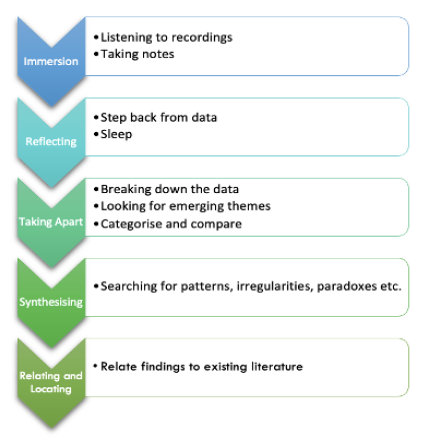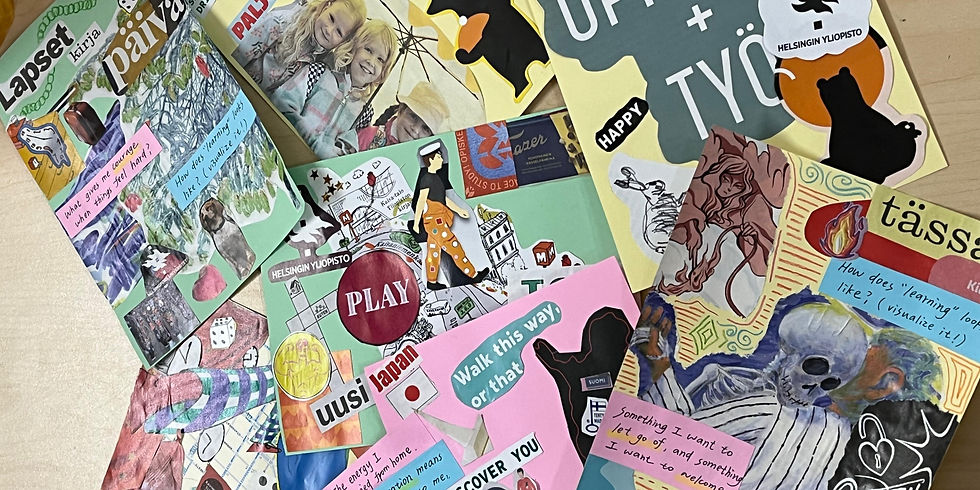Understanding Adolescents' Awareness of TikTok Risks: A Qualitative Study in Indonesia
- Maria Aguar Pla, Ariadna Garcia i Pelegrin, Janosch Krüger, Dippya Widiatmika
- 4 days ago
- 10 min read
This study design aims to explore Indonesian adolescents’ awareness of the risks associated with TikTok, using focus group discussions to understand how they perceive and navigate both immediate and cumulative dangers, such as privacy issues, addiction, and mental health effects. It aims to fill a research gap by examining not just the risks themselves but also how adolescents learn about them and the factors influencing their awareness. 1. INTRODUCTION
TikTok has rapidly emerged as one of the world's most popular social media platforms, but its rise comes with significant risks, particularly for younger users. Their timeline, the For You Page (FYP), is central to TikTok's user experience. Users' feeds are curated by algorithms based on their preferences and behavior (e.g., what they watch, like, and search) instead of user relationships (Schellewald, 2021). This unique feature distinguishes it from other social media platforms.
TikTok was initially famous for light-hearted content like dance challenges and comedic videos. However, the contents have evolved, and younger users now utilize them for educational purposes, such as homework and discussing literature (Langreo, 2022). Since the onset of the COVID-19 pandemic, TikTok has seen exponential growth in user numbers, driven by social isolation, boredom, and the increased need for virtual interaction. As of 2024, TikTok has 1.582 billion active users worldwide (Statista, 2024), supported by 11 offices globally, including one in Jakarta, Indonesia.
Indonesia ranks first globally in TikTok usage, with 157,6 million active accounts, representing 10% of the platform’s global user base (Statista, 2024b) and 56% of the country’s population. Adolescents constitute 18% of the Indonesian population, accounting for over 43.5 million individuals, of which 38.7% are TikTok users (Hidayat et al., 2022). Furthermore, adolescents’ vulnerability to harmful content makes this a critical area to study. Adolescents are at a crucial developmental stage, and their identities and cognitive abilities are still developing (Rodriguez & Zhao, 2024).
Despite its popularity, TikTok also has significant risks to its users. The platform’s algorithm may expose users, particularly adolescents, to inappropriate and addictive content (Bozzola et al., 2022; Lu et al., 2020). Additionally, TikTok has been associated with adverse mental health outcomes, such as anxiety and low self-esteem (Bozzola et al., 2022). Although existing literature has addressed potential risks associated with TikTok use, there is a notable gap in understanding adolescents’ awareness of these risks (Cernikova et al., 2017). This study aims to fill that gap and contribute to the overall research on adolescents' cognitive capabilities and perceptions of the risks posed by social media.
Keywords: TikTok, Social Media, Adolescents, Risks-Dangers, Mental Health
2. OBJECTIVES OF THE STUDY AND RESEARCH QUESTIONS
Since this is an exploratory study utilizing extensive focus group research, we aim to gather insights into the wide range of risks associated with TikTok, exploring this relatively uncharted area of research. This approach allows us to identify surface-level risks and delve deeper into adolescents' levels of awareness. Consequently, our main research questions are formulated broadly, allowing us to explore a broader scope and be flexible within the focus group meetings. The questions are as follows:
1. To what extent are Indonesian adolescents aware of TikTok’s various risks?
2. What are the primary sources of information adolescents rely on to learn about these risks?
3. What factors contribute to adolescent’s awareness of risks?
3. THEORETICAL LITERATURE REVIEW
Most research on adolescents' awareness of social media risks has focused on privacy and security. While these are crucial areas that will be further explored in this study, the extent to which adolescents are aware of other potential risks remains to be determined. Cernikova et al. (2017) note that qualitative, child-centered research is scarce, as most studies on social media perceptions have been quantitative. In their focus group-based research, Cernikova suggest that adolescents can demonstrate awareness of health-related consequences linked to social media use. However, at the time of that study, TikTok had yet to become a significant platform of concern. Vaterlaus and Winter (2021) emphasize the need for qualitative research when new media emerge, arguing that it provides "rich descriptions of lived experiences" (p. 3) and generates measures that can serve as foundations for future quantitative studies.
Immediate and cumulative risks
This study categorized adolescents’ TikTok risks into two broad categories: immediate and cumulative. This distinction offers a more transparent framework for understanding the depth and complexity of the potential risks. Immediate risks arise directly from interactions with the platform, manifesting quickly in users' behavior or health. On the other hand, cumulative risks build up over time, often involving cognitive or emotional processes that may be less obvious but no less impactful.
This classification allows us to analyze the visibility of these risks and the cognitive awareness adolescents may or may not have. While many teens can recognize the immediate risks tied to their TikTok use, they might overlook the more subtle, long-term dangers associated with repeated exposure or behavioral patterns.
In their scoping review, Bozolla et al. (2022) identified various risks linked to social media use. Based on their work, we classify immediate risks as including obesity, cyberbullying, sleep disruption, substance abuse, following trends, high-risk behaviors, and compromised privacy. Cumulative risks include body image concerns, phone addiction, unhealthy marketing influences, and mental health issues like stress, depression, and anxiety. Moreover, TikTok-specific research by Sha and Dong (2021) also highlights memory loss as a risk, especially in male users. Lu et al. (2020) further revealed that Chinese students knew the risk of wasting time and becoming addicted to TikTok, suggesting a meta-cognitive awareness of the app's dangers.
Shao (2009) identified three primary ways individuals interact with user-generated content: passive consumption, participation, and contribution. Among these, adolescents’ passive use—often motivated by entertainment and fun—is especially prevalent (Bossen & Kottasz, 2020). This passive behavior, which typically involves no social interaction or the formation of new connections, has been linked to adverse outcomes such as low self-esteem, loneliness, and psychological distress (Tanta et al., 2014). Conversely, contributing users seek gratifications related to self-expression, identity creation, and fame, engaging in what Bossen and Kottasz (2020) describe as "serious fun." While this active participation can foster creativity, it raises concerns about adolescents experimenting with online identities and creating unrealistic expectations regarding fame and friendships. These behaviors contribute to further psychological risks, amplifying the cumulative dangers of TikTok use.
Media Panic Theory
Cernikova et al. (2017) apply media panic theory to explain why adolescents’ perceptions of risks may sometimes be distorted. Media panic theory highlights the tendency for media outlets to sensationalize morally charged, emotional scenarios, especially when it comes to newer platforms like TikTok. The qualitative approach in this study will explore how aware adolescents are of these risks and to what extent their views may be shaped by sensationalist media coverage. Moreover, this study provides a platform for adolescents to discuss the sources of their knowledge about TikTok's risks, offering valuable insights into the origins of their risk awareness. This issue is critical when considering mental health, as a dangerous "self-diagnosis" trend is circulating on TikTok. Foster and Ellis (2024) highlight the risks this poses for young people, who are particularly vulnerable at this stage of development. With unrestricted access to information, they will likely encounter medically inaccurate and possibly sensationalized content. This underscores the significance of our second research question.
4. DRAFT OF THE RESEARCH METHOD
Qualitative research explores how participants interpret social issues using interviews and discussions to gather non-numeric data. As stated by Tümen-Akyildiz and Ahmed (2021), Lauri (2019) emphasized the value of understanding specific hypotheses by uncovering underlying factors behind behaviours. This study employs focus group discussions as the primary method as they suited the explorative nature of this research on adolescents' awareness.
We opted for focus groups in our research due to their effectiveness in gaining deeper insights, especially when limited information is available on a topic. By using semi-structured interviews, focus groups enable participants to explore their emotions, thoughts, and experiences, making them particularly suitable for discussing sensitive issues in a more comfortable setting (Wisker, 2001). Moreover, children are often motivated to express their thoughts and feelings clearly to peers (Adler et al., 2019)
Focus Group Formation
Groups will be formed according to age, as familiarity with peers may encourage more open sharing of thoughts and experiences (Adler et al., 2019). Conversely, participants may be less willing to discuss sensitive topics, such as mental health, when grouped with strangers or individuals they cannot relate to. Additionally, studies suggest that a group size of around 4 to 6 is ideal for working with adolescents (Peterson-Sweeney, 2005). Larger groups may inhibit open communication due to fear of sharing in front of too many people, leading to more profound and meaningful contributions.
The questions during the interviews will be open-ended and guided by the risks outlined in the literature review (see appendix). They will cover participants' TikTok
usage patterns, perceptions of privacy and safety, personal experiences with harmful content, and awareness of potential risks. As Adler et al. (2019) recommended, follow-up questions will be used to gather more detailed information and clarify participants' perspectives.
Focus groups will be held in five major cities: Jakarta, Yogyakarta, Medan, Makassar, and Denpasar, with ten groups per city to ensure diverse representation. These cities were chosen for their economic, cultural, and population significance, offering a broad demographic mix. Their infrastructure also facilitates participant recruitment and organization.
5. DRAFT FOR THE DATA
Following the focus group discussions, audio recordings, corresponding transcripts, and their translations will be collected. This approach ensures that no information is lost, capturing both the content and nuances of participants’ responses while creating a comprehensive written record for detailed analysis. The resulting data will offer substantial qualitative insights, serving as a valuable resource for further analysis.
6. TENTATIVE DATA ANALYSIS METHOD
As recommended by Onwuegbuzie et al. (2009) for the analysis of focus group data, the Constant Comparison Model, as outlined by Wellington (2015), will be followed to process the data systematically, step-by-step. After the translation process, the next stage will involve listening to the recordings and reviewing the transcripts. This process will mark the beginning of coding, where the data will be organized into themes to facilitate interpretation (Baralt, 2012). The data will be broken down by identifying recurring words or themes across the interviews.

Subsequently, the identified themes will be compared with the literature review to confirm existing findings or reveal new insights. Emerging risks will be categorized as immediate outcomes, offering deeper insights into existing risks or introducing new risks and perspectives to the literature. Additionally, using media panic theory, participants' statements will be analyzed to identify potential distortion.
7. CONCLUSION
This research aims to provide extensive qualitative insights into Indonesian adolescents' awareness of the risks associated with TikTok. Through focus group discussions in five major cities, we expect to uncover both immediate and cumulative risks that adolescents may not be fully aware of.
Limitations
This study has several limitations. One possible limitation, as Rodriguez and Zhao (2024) point out, is the "deficit-based, harm-oriented approach to understanding children's experiences on short video platforms” (p. 7). We acknowledge that our study aligns with this approach, often fuelled by media narratives and political discourse. They also stated that adolescents may have negative and positive experiences with TikTok. Therefore, we recognize the duality of their experience and will not overlook any positive experiences that may emerge from the focus group discussions.
Additionally, the focus group data does not fully represent all Indonesian adolescents due to the sample size and the selection of urban cities. Cultural and regional differences may result in varying risk perceptions across Indonesia. Moreover, TikTok operates under different restrictions and regulations in various countries, significantly impacting adolescents' risks.
Future Research and Implications
Future research should address these limitations by exploring adolescent awareness in more diverse regions within Indonesia and globally. Cross-national comparisons could reveal how local regulations shape risk perception and highlight new online behaviour patterns. Moreover, these findings can be used as a hypothesis to conduct more quantitative studies on adolescents’ risk awareness (Vaterlaus & Winter, 2021). Expanding the research scope to other countries would provide valuable comparative insights, aiding policymakers and educators in developing more effective strategies to protect young users across diverse cultural contexts.
You can download the file from here :
REFERENCES
Adler, K., Salanterä, S., & Zumstein-Shaha, M. (2019). Focus group interviews in child, youth, and parent research: An integrative literature review—International Journal of Qualitative Methods, 18, 160940691988727.
Baralt, M. (2012). 12 Coding Qualitative Data. Research methods in second language acquisition, 222
Bossen, C. B., & Kottasz, R. (2020). Uses and gratifications sought by pre-adolescent and adolescent TikTok consumers. Young Consumers Insight and Ideas for Responsible Marketers, 21(4), 463–478. https://doi.org/10.1108/yc-07-2020- 1186
Bozzola, E., Spina, G., Agostiniani, R., Barni, S., Russo, R., Scarpato, E., Di Mauro, A., Di Stefano, A. V., Caruso, C., Corsello, G., & Staiano, A. (2022). The Use of Social Media in Children and Adolescents: Scoping Review on the Potential Risks. International Journal of Environmental Research and Public Health, 19(16), 9960. https://doi.org/10.3390/ijerph19169960
Cernikova, M., Smahel, D., & Wright, M. F. (2017). Children’s Experiences and Awareness about Impact of Digital Media on Health. Health Communication, 33(6), 664–673. https://doi.org/10.1080/10410236.2017.1298197
Falgoust, G., Winterlind, E., Moon, P., Parker, A., Zinzow, H., & Madathil, K. C. (2022). Applying the uses and gratifications theory to identify motivational factors behind young adults’ participation in viral social media challenges on TikTok. Human Factors in Healthcare, 2, 100014. https://doi.org/10.1016/j.hfh.2022.100014
Foster, A., & Ellis, N. (2024). TikTok-inspired self-diagnosis and its implications for educational psychology practice. Educational Psychology in Practice, pp. 1–18. https://doi.org/10.1080/02667363.2024.2409451
Hancock, B., Ockleford, E., & Windridge, K. (2001). An introduction to qualitative research: Trent focus group.
Hidayat, F. P., Lubis, F. H., Hardiyanto, S., Ananda, F. R., & Anfasa, I. (2022). The Impact of Social Media Use on Adolescents: International Conference on Communication, Policy and Social Science (InCCluSi, 2022), Medan, Indonesia. https://doi.org/10.2991/978-2-494069-07-7_22
Langreo, L. (2022, November 16). Students Are Turning to TikTok for Homework Help. Is That a Bad Thing? EducationWeek. https:/developmental.org/tecand hnology/students-are-turning-to-tiktok-for-homeworkdevelopings-that-a-bad thing/2022/11.
Lauri, M. A. (2019). WASP (Write a Scientific Paper): Collecting qualitative data using focus groups. Early human development, pp. 133, 65–68.
Lu, X., Lu, Z., & Liu, C. (2020). Exploring TikTok Use and Non-use Practices and Experiences in China. In Lecture notes in computer science (pp. 57–70). https://doi.org/10.1007/978-3-030-49576-3_5
Mona, L. S., & Irman, I. (2024). EFEK KECANDUAN MEDIA TIK TOK TERHADAP PERILAKU SOSIAL REMAJA. JURNAL MAHASISWA BK AN-NUR BERBEDA BERMAKNA MULIA, 10(1), 127. https://doi.org/10.31602/jmbkan.v10i1.13086
Peterson-Sweeney, K. (2005). The use of focus groups in pediatric and adolescent research. Journal of Pediatric Health Care, 19(2), 104–110. https://doi.org/10.1016/j.pedhc.2004.08.006
Rodriguez, A., & Zhao, X. (2024). Pushing against the panic: Considering the positives of TikTok and children. International Journal of Cultural Studies. https://doi.org/10.1177/13678779241276011
Schellewald, A. (2021). Communicative Forms on TikTok: Perspectives From Digital Ethnography. In International Journal of Communication (Vol. 15). http://ijoc.org. Sha, P., & Dong, X. (2021). Research on Adolescents Regarding the Indirect Effect of Depression, Anxiety, and Stress between TikTok Use Disorder and Memory Loss. International Journal of Environmental Research and Public Health, 18(16), 8820. https://doi.org/10.3390/ijerph18168820
Shao, G. (2009). Understanding the appeal of user‐generated media: a uses and gratification perspective. Internet Research, 19(1), 7–25. https://doi.org/10.1108/10662240910927795
Shiddiq, S., & Taufik, M. (2024). Pengaruh Gratifikasi Instan Aplikasi TikTok terhadap Perilaku Belajar Siswa. Idarah Tarbawiyah Journal of Management in Islamic Education, 5(3), 299–306. https://doi.org/10.32832/itjmie.v5i3.16625
Statista. (2024a). Most popular social networks worldwide as of April 2024, by number of monthly active users. https://www.statista.com/statistics/272014/global-social networks-ranked-by-number-of-users/.
Statista. (2024b). Countries with the largest TikTok audience as of July 2024. https://www.statista.com/statistics/1299807/number-of-monthly-unique-tiktok users/.
Tanta, I., Mihovilović, M., & Sablić, Z. (2014, December 15). Uses and Gratification Theory – Why Adolescents Use Facebook? https://hrcak.srce.hr/133809 Tümen-Akyıldız, S., & Ahmed, K.H. (2021). An overview of qualitative research and focus group discussion. Journal of Academic Research in Education, 7(1), 1-15. DOI: 10.17985/ijare.866762 → Qualitative research
Vaterlaus, J. M., & Winter, M. (2021). TikTok: An exploratory study of young adults’ uses and gratifications. The Social Science Journal, 1–20. https://doi.org/10.1080/03623319.2021.1969882
Wellington, J. (2015). Educational research: Contemporary issues and practical approaches. Bloomsbury Publishing.




Comments